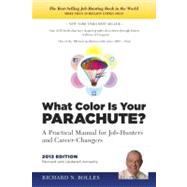
Note: Supplemental materials are not guaranteed with Rental or Used book purchases.
Purchase Benefits
What is included with this book?
| Preface I'm Desperate: How Can a Book Help? | p. xii |
| A Grammar and Language Note | p. xv |
| The Basics for Job-Hunters and Career-Changers | |
| How to Find Hope | p. 1 |
| The Seven Secrets About the Job-Market Today | p. 11 |
| The Best and Worst Ways to Look for Jobs | p. 23 |
| Life/Work Planning: Designing a Plan of Attack | p. 41 |
| You Need to Understand More Fully Who You Are | p. 51 |
| Networking and Social Media | p. 127 |
| Five Ways to Choose or Change Careers | p. 167 |
| Do I Really Need a Resume? | p. 181 |
| Sixteen Tips About Interviewing | p. 201 |
| How to Deal with Handicaps (Real or Imagined) | p. 227 |
| The Six Secrets of Salary Negotiation | p. 239 |
| Starting Your Own Business | p. 255 |
| The Pink Pages | |
| Finding Your Mission in Life | p. 272 |
| A Guide to Dealing with Your Feelings While Out of Work | p. 294 |
| A Guide to Choosing a Career Coach or Counselor | p. 303 |
| Sampler List of Coaches | p. 319 |
| About the Author | p. 339 |
| Index | p. 340 |
| Update 2013 | p. 347 |
| Foreign Editions of What Color Is Your Parachute? | p. 348 |
| Additional Helpful Resources from the Author: Books | p. 349 |
| Table of Contents provided by Ingram. All Rights Reserved. |
The New copy of this book will include any supplemental materials advertised. Please check the title of the book to determine if it should include any access cards, study guides, lab manuals, CDs, etc.
The Used, Rental and eBook copies of this book are not guaranteed to include any supplemental materials. Typically, only the book itself is included. This is true even if the title states it includes any access cards, study guides, lab manuals, CDs, etc.